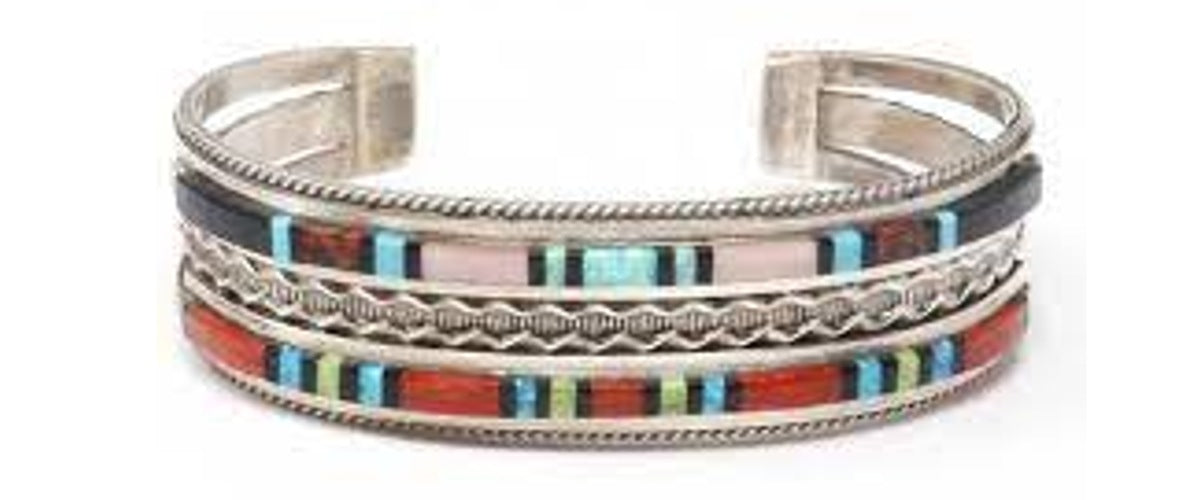
The Zuni reservation extends across almost half a million acres of scenic high desert in New Mexico, to the west of Alberquerque and south of Gallup. Among our large and diverse catalog of Native American jewelry we offer here at Indian Traders, we have a stunning selection of genuine pieces handcrafted by local Zuni artists.
Zuni jewelry is characterised by its extremely intricate workmanship – unlike the characteristic large, more naturally-shaped stones and embellished silverwork of Navajo jewlery, or the distinctive silver overlay jewelry of the Hopi, Zuni jewelry uses stones that are smaller, ground and polished, and set within a lighter metal framework.
Understanding what makes Zuni jewelry so special, the stories behind the designs, and the history of how this distinctive method of silversmithing came to be, is part of the experience of enjoying your Zuni necklace, bracelet, earrings, or other piece of wearable art.
Who Are the Zuni?
The Zuni is a relatively small Native American tribe Indigenous to the Zuni River area of New Mexico. Here the ancestors of modern-day Zuni people established settlements with villages (pueblos) of multi-storey adobe dwellings. Resident there for thousands of years, they traditionally farmed the land and raised livestock.
By the 1500s, these pueblos were also known (according to Aztec mythology) as the “Seven Cities of Gold” and were reputed to have been filled with gold, silver, emeralds, turquoise, and other precious and semi-precious gemstones. This lured the expedition of Spanish explorer Coronado to Zuni lands in 1540. The Spanish expeditions did find the Pueblo lands to be rich with copper and turquoise mines.
Today, there are approximately ten thousand official Zuni tribal members and, for a majority of them, creating art and craft is their livelihood. The Zuni are renowned for being highly creative and talented carvers, potters, painters, and jewelers.
History & Features of Zuni Jewelry
Since ancient times, the Zuni have been renowned for their lapidary (stonework) skills and creation of carved animal fetishes from stone, coral, and shell; these were used ceremonially with each believed to hold its own inherent power. Fetishes were used for everything from controlling the weather to war ceremonies, curing illness, protection against curses, and even gambling luck.
In the 1830s, the Zuni learned how to work brass and copper. A few decades later in 1872, traveling Navajo man Atsidi Chon taught Zuni tribesman Lanyade the art of silversmithing. (The Navajo had been themselves taught by Spanish explorers/settlers). While early silversmithing was primarily used for practical purposes such as crafting tools and weapons, the silver captured the attention of the tribe’s artisans and using these techniques to make jewelry soon followed.
This early Zuni jewelry closely resembled the Navajo style - made from silver coins that were hand-engraved and hammered into the desired designs. Turquoise was incorporated into Zuni jewelry from around 1890.
Thanks to the availability of higher-quality materials and more effective tools, Zuni craftsmanship dramatically evolved and flourished after 1920. The distinctive styles we see today were born – marrying silversmithing with lapidary work for mosaic and channel inlays, fetish necklaces, needle point, petit point, and very intricate stonework incorporating not only turquoise but also onyx, jet, coral, pink mussel and other types of shell, lapis, lab opal, and even fossilized ivory.
Unlike Navajo pieces, the turquoise used by the Zuni tends to feature little or no matrix, is more uniform in appearance, and the stones are often set to sit flush against each other.
In the 1930s, white American trader Charles Garrett Wallace bought the local trading post and identified an economically viable and financially rewarding opportunity for non-Native tourists along Route 66 and the Santa Fe Railroad to discover Zuni jewelry for themselves. He furnished the local Zuni people with modern equipment and encouraged them to create larger amounts of jewelry for this purpose.
Zuni Jewelry Styles
- Channel Inlay features cut stones set precisely into silver (or other metal) channels – unlike mosaic inlay, each stone is individually surrounded by the metal.
- Mosaic Inlay sees lapidary cut stones set together and against each other to form the desired design or pattern. They are stabilized onto a silver or copper (or another metal) backing plate and polished into a uniform, flat surface.
- Needle Point features stones cut into needle shapes and formed into elegant patterns.
- Petit Point is a lapidary technique whereby turquoise or another stone is cut into a small, precise shape and set in a clustered form to create a distinctive design. The stones may be cut square, rectangular, circular, ovular, or pear-shaped.
Buy Zuni Jewelry at Indian Traders
We have a large selection of spectacular Zuni bracelets, necklaces, pendants, earrings, money clips and more. These distinctive pieces are handmade by